Social Class and Inequality: Effects on Student Achievement Explored
VerifiedAdded on 2023/06/04
|8
|2064
|234
Essay
AI Summary
This essay delves into the pervasive issue of social class and inequality within the education system, arguing that students from lower socioeconomic backgrounds often face significant disadvantages in academic achievement. It explores how factors such as financial constraints, time poverty, and the quality of school resources contribute to these disparities. The essay also examines relevant social theories, like functionalism and conflict theory, to understand the perpetuation of inequality and discusses the impact of teacher expectations on student performance. While acknowledging the challenges, the essay also highlights instances where students from disadvantaged backgrounds demonstrate resilience and excel academically. Finally, it touches upon government programs aimed at mitigating these inequalities, emphasizing the need for comprehensive interventions to promote equitable educational opportunities. Access more essays and resources on Desklib.
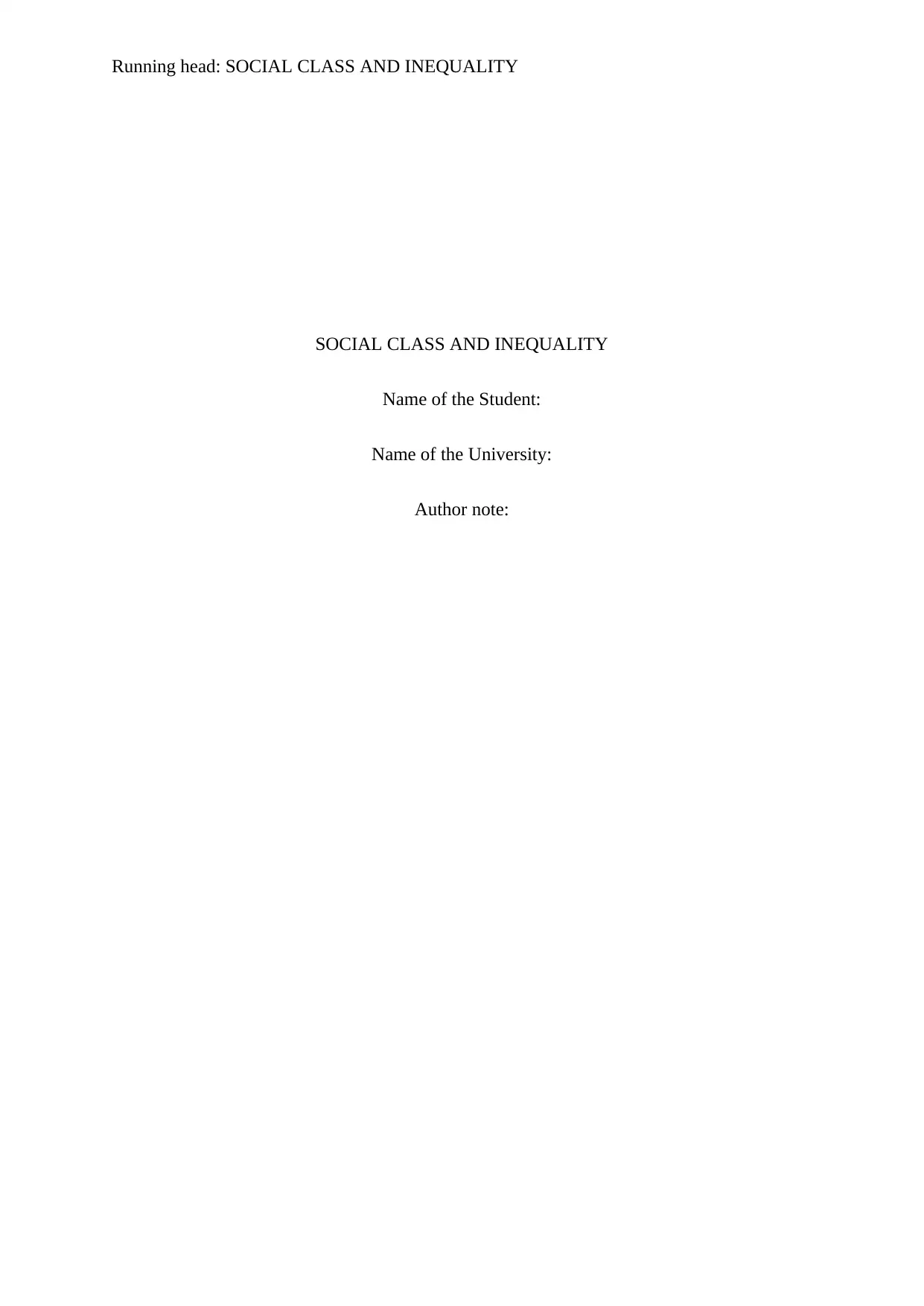
Running head: SOCIAL CLASS AND INEQUALITY
SOCIAL CLASS AND INEQUALITY
Name of the Student:
Name of the University:
Author note:
SOCIAL CLASS AND INEQUALITY
Name of the Student:
Name of the University:
Author note:
Paraphrase This Document
Need a fresh take? Get an instant paraphrase of this document with our AI Paraphraser
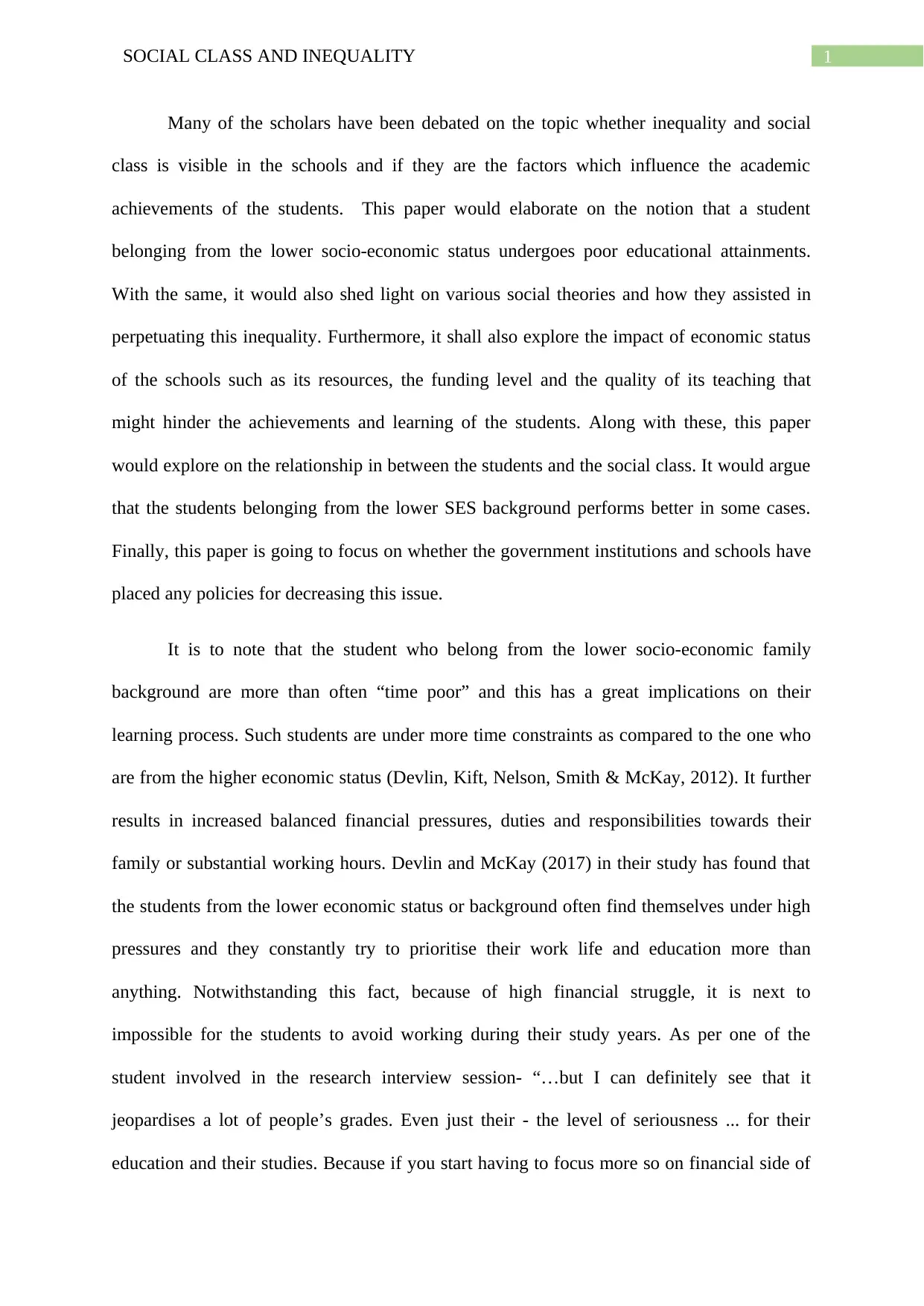
1SOCIAL CLASS AND INEQUALITY
Many of the scholars have been debated on the topic whether inequality and social
class is visible in the schools and if they are the factors which influence the academic
achievements of the students. This paper would elaborate on the notion that a student
belonging from the lower socio-economic status undergoes poor educational attainments.
With the same, it would also shed light on various social theories and how they assisted in
perpetuating this inequality. Furthermore, it shall also explore the impact of economic status
of the schools such as its resources, the funding level and the quality of its teaching that
might hinder the achievements and learning of the students. Along with these, this paper
would explore on the relationship in between the students and the social class. It would argue
that the students belonging from the lower SES background performs better in some cases.
Finally, this paper is going to focus on whether the government institutions and schools have
placed any policies for decreasing this issue.
It is to note that the student who belong from the lower socio-economic family
background are more than often “time poor” and this has a great implications on their
learning process. Such students are under more time constraints as compared to the one who
are from the higher economic status (Devlin, Kift, Nelson, Smith & McKay, 2012). It further
results in increased balanced financial pressures, duties and responsibilities towards their
family or substantial working hours. Devlin and McKay (2017) in their study has found that
the students from the lower economic status or background often find themselves under high
pressures and they constantly try to prioritise their work life and education more than
anything. Notwithstanding this fact, because of high financial struggle, it is next to
impossible for the students to avoid working during their study years. As per one of the
student involved in the research interview session- “…but I can definitely see that it
jeopardises a lot of people’s grades. Even just their - the level of seriousness ... for their
education and their studies. Because if you start having to focus more so on financial side of
Many of the scholars have been debated on the topic whether inequality and social
class is visible in the schools and if they are the factors which influence the academic
achievements of the students. This paper would elaborate on the notion that a student
belonging from the lower socio-economic status undergoes poor educational attainments.
With the same, it would also shed light on various social theories and how they assisted in
perpetuating this inequality. Furthermore, it shall also explore the impact of economic status
of the schools such as its resources, the funding level and the quality of its teaching that
might hinder the achievements and learning of the students. Along with these, this paper
would explore on the relationship in between the students and the social class. It would argue
that the students belonging from the lower SES background performs better in some cases.
Finally, this paper is going to focus on whether the government institutions and schools have
placed any policies for decreasing this issue.
It is to note that the student who belong from the lower socio-economic family
background are more than often “time poor” and this has a great implications on their
learning process. Such students are under more time constraints as compared to the one who
are from the higher economic status (Devlin, Kift, Nelson, Smith & McKay, 2012). It further
results in increased balanced financial pressures, duties and responsibilities towards their
family or substantial working hours. Devlin and McKay (2017) in their study has found that
the students from the lower economic status or background often find themselves under high
pressures and they constantly try to prioritise their work life and education more than
anything. Notwithstanding this fact, because of high financial struggle, it is next to
impossible for the students to avoid working during their study years. As per one of the
student involved in the research interview session- “…but I can definitely see that it
jeopardises a lot of people’s grades. Even just their - the level of seriousness ... for their
education and their studies. Because if you start having to focus more so on financial side of
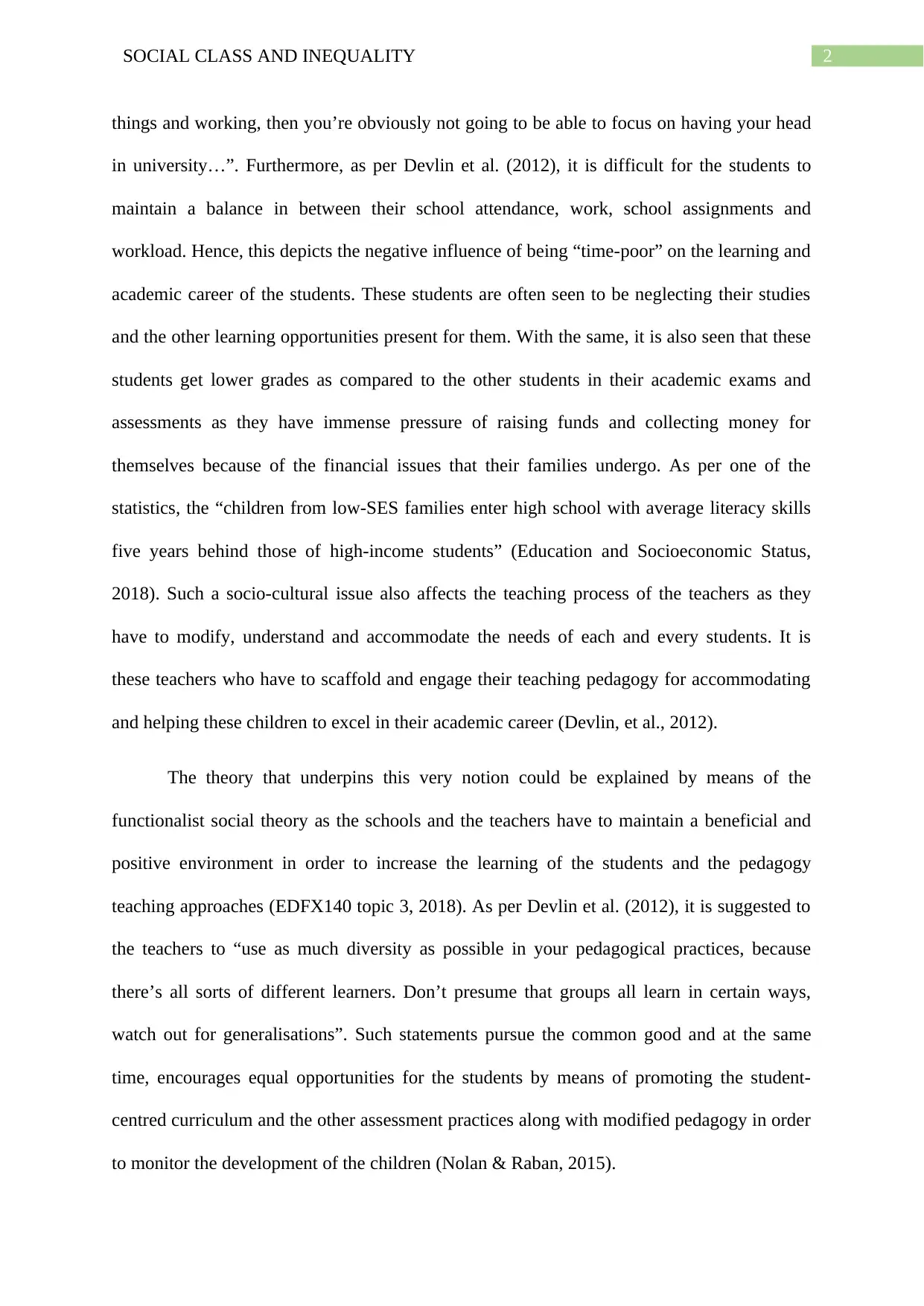
2SOCIAL CLASS AND INEQUALITY
things and working, then you’re obviously not going to be able to focus on having your head
in university…”. Furthermore, as per Devlin et al. (2012), it is difficult for the students to
maintain a balance in between their school attendance, work, school assignments and
workload. Hence, this depicts the negative influence of being “time-poor” on the learning and
academic career of the students. These students are often seen to be neglecting their studies
and the other learning opportunities present for them. With the same, it is also seen that these
students get lower grades as compared to the other students in their academic exams and
assessments as they have immense pressure of raising funds and collecting money for
themselves because of the financial issues that their families undergo. As per one of the
statistics, the “children from low-SES families enter high school with average literacy skills
five years behind those of high-income students” (Education and Socioeconomic Status,
2018). Such a socio-cultural issue also affects the teaching process of the teachers as they
have to modify, understand and accommodate the needs of each and every students. It is
these teachers who have to scaffold and engage their teaching pedagogy for accommodating
and helping these children to excel in their academic career (Devlin, et al., 2012).
The theory that underpins this very notion could be explained by means of the
functionalist social theory as the schools and the teachers have to maintain a beneficial and
positive environment in order to increase the learning of the students and the pedagogy
teaching approaches (EDFX140 topic 3, 2018). As per Devlin et al. (2012), it is suggested to
the teachers to “use as much diversity as possible in your pedagogical practices, because
there’s all sorts of different learners. Don’t presume that groups all learn in certain ways,
watch out for generalisations”. Such statements pursue the common good and at the same
time, encourages equal opportunities for the students by means of promoting the student-
centred curriculum and the other assessment practices along with modified pedagogy in order
to monitor the development of the children (Nolan & Raban, 2015).
things and working, then you’re obviously not going to be able to focus on having your head
in university…”. Furthermore, as per Devlin et al. (2012), it is difficult for the students to
maintain a balance in between their school attendance, work, school assignments and
workload. Hence, this depicts the negative influence of being “time-poor” on the learning and
academic career of the students. These students are often seen to be neglecting their studies
and the other learning opportunities present for them. With the same, it is also seen that these
students get lower grades as compared to the other students in their academic exams and
assessments as they have immense pressure of raising funds and collecting money for
themselves because of the financial issues that their families undergo. As per one of the
statistics, the “children from low-SES families enter high school with average literacy skills
five years behind those of high-income students” (Education and Socioeconomic Status,
2018). Such a socio-cultural issue also affects the teaching process of the teachers as they
have to modify, understand and accommodate the needs of each and every students. It is
these teachers who have to scaffold and engage their teaching pedagogy for accommodating
and helping these children to excel in their academic career (Devlin, et al., 2012).
The theory that underpins this very notion could be explained by means of the
functionalist social theory as the schools and the teachers have to maintain a beneficial and
positive environment in order to increase the learning of the students and the pedagogy
teaching approaches (EDFX140 topic 3, 2018). As per Devlin et al. (2012), it is suggested to
the teachers to “use as much diversity as possible in your pedagogical practices, because
there’s all sorts of different learners. Don’t presume that groups all learn in certain ways,
watch out for generalisations”. Such statements pursue the common good and at the same
time, encourages equal opportunities for the students by means of promoting the student-
centred curriculum and the other assessment practices along with modified pedagogy in order
to monitor the development of the children (Nolan & Raban, 2015).
⊘ This is a preview!⊘
Do you want full access?
Subscribe today to unlock all pages.

Trusted by 1+ million students worldwide
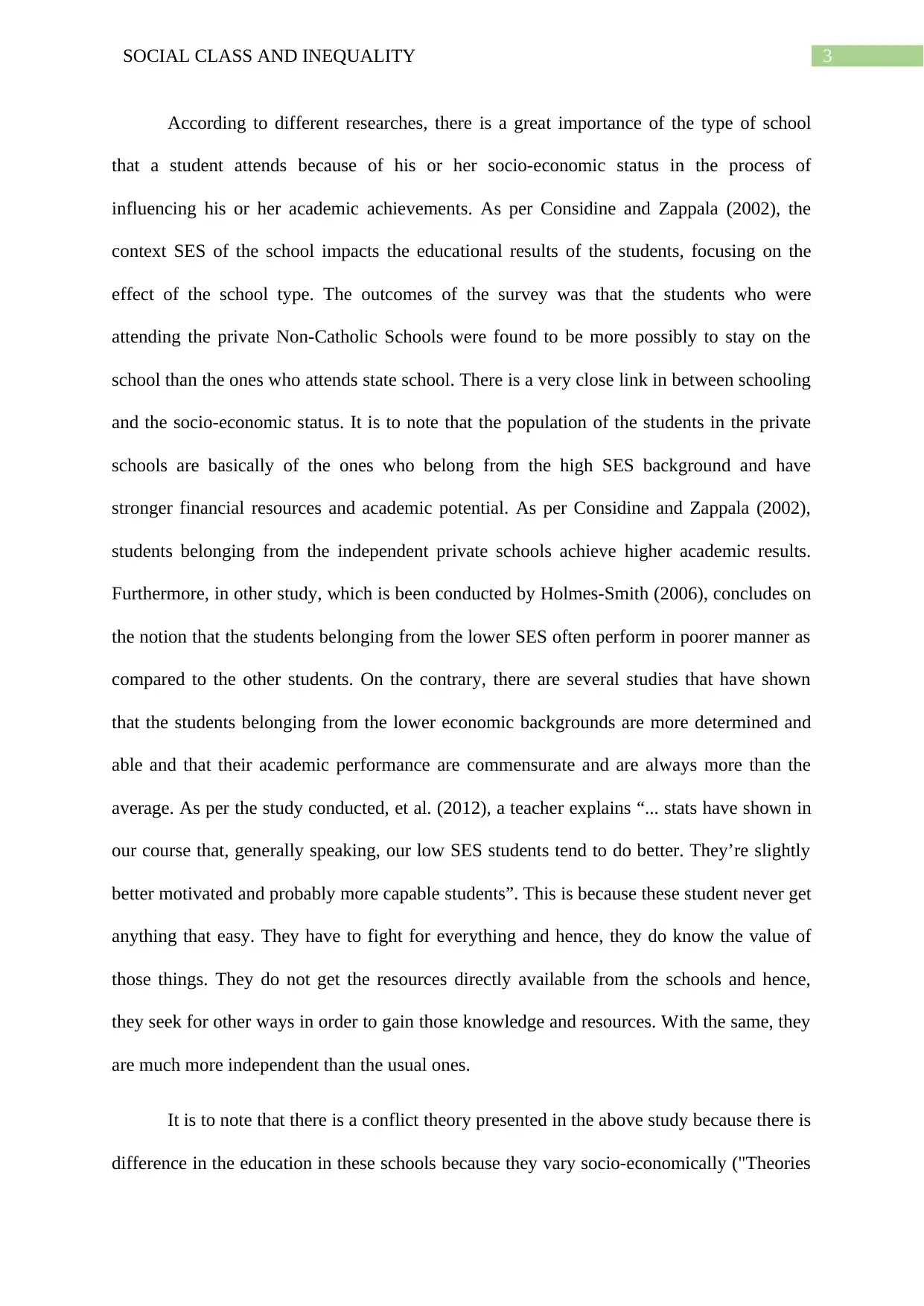
3SOCIAL CLASS AND INEQUALITY
According to different researches, there is a great importance of the type of school
that a student attends because of his or her socio-economic status in the process of
influencing his or her academic achievements. As per Considine and Zappala (2002), the
context SES of the school impacts the educational results of the students, focusing on the
effect of the school type. The outcomes of the survey was that the students who were
attending the private Non-Catholic Schools were found to be more possibly to stay on the
school than the ones who attends state school. There is a very close link in between schooling
and the socio-economic status. It is to note that the population of the students in the private
schools are basically of the ones who belong from the high SES background and have
stronger financial resources and academic potential. As per Considine and Zappala (2002),
students belonging from the independent private schools achieve higher academic results.
Furthermore, in other study, which is been conducted by Holmes-Smith (2006), concludes on
the notion that the students belonging from the lower SES often perform in poorer manner as
compared to the other students. On the contrary, there are several studies that have shown
that the students belonging from the lower economic backgrounds are more determined and
able and that their academic performance are commensurate and are always more than the
average. As per the study conducted, et al. (2012), a teacher explains “... stats have shown in
our course that, generally speaking, our low SES students tend to do better. They’re slightly
better motivated and probably more capable students”. This is because these student never get
anything that easy. They have to fight for everything and hence, they do know the value of
those things. They do not get the resources directly available from the schools and hence,
they seek for other ways in order to gain those knowledge and resources. With the same, they
are much more independent than the usual ones.
It is to note that there is a conflict theory presented in the above study because there is
difference in the education in these schools because they vary socio-economically ("Theories
According to different researches, there is a great importance of the type of school
that a student attends because of his or her socio-economic status in the process of
influencing his or her academic achievements. As per Considine and Zappala (2002), the
context SES of the school impacts the educational results of the students, focusing on the
effect of the school type. The outcomes of the survey was that the students who were
attending the private Non-Catholic Schools were found to be more possibly to stay on the
school than the ones who attends state school. There is a very close link in between schooling
and the socio-economic status. It is to note that the population of the students in the private
schools are basically of the ones who belong from the high SES background and have
stronger financial resources and academic potential. As per Considine and Zappala (2002),
students belonging from the independent private schools achieve higher academic results.
Furthermore, in other study, which is been conducted by Holmes-Smith (2006), concludes on
the notion that the students belonging from the lower SES often perform in poorer manner as
compared to the other students. On the contrary, there are several studies that have shown
that the students belonging from the lower economic backgrounds are more determined and
able and that their academic performance are commensurate and are always more than the
average. As per the study conducted, et al. (2012), a teacher explains “... stats have shown in
our course that, generally speaking, our low SES students tend to do better. They’re slightly
better motivated and probably more capable students”. This is because these student never get
anything that easy. They have to fight for everything and hence, they do know the value of
those things. They do not get the resources directly available from the schools and hence,
they seek for other ways in order to gain those knowledge and resources. With the same, they
are much more independent than the usual ones.
It is to note that there is a conflict theory presented in the above study because there is
difference in the education in these schools because they vary socio-economically ("Theories
Paraphrase This Document
Need a fresh take? Get an instant paraphrase of this document with our AI Paraphraser
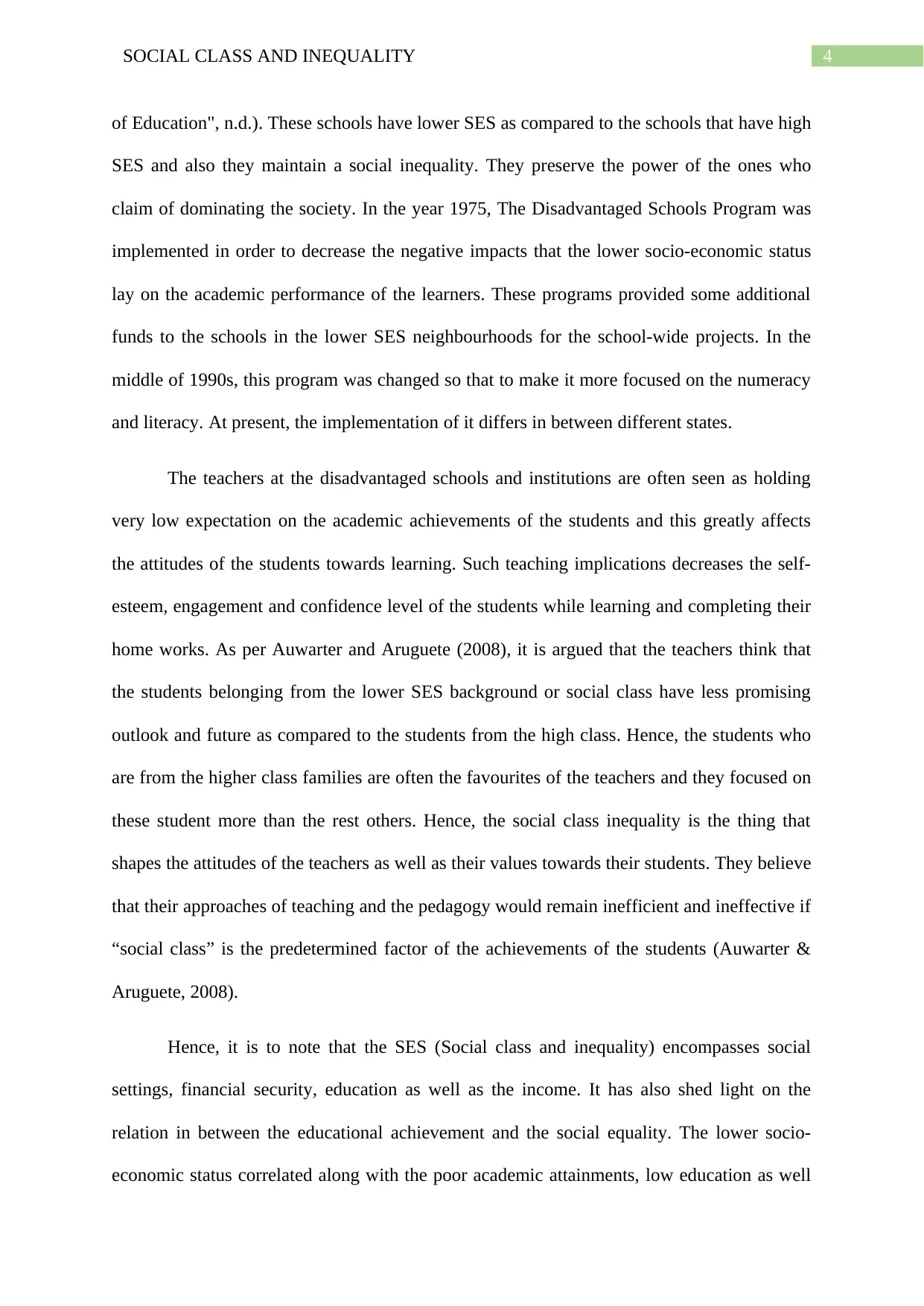
4SOCIAL CLASS AND INEQUALITY
of Education", n.d.). These schools have lower SES as compared to the schools that have high
SES and also they maintain a social inequality. They preserve the power of the ones who
claim of dominating the society. In the year 1975, The Disadvantaged Schools Program was
implemented in order to decrease the negative impacts that the lower socio-economic status
lay on the academic performance of the learners. These programs provided some additional
funds to the schools in the lower SES neighbourhoods for the school-wide projects. In the
middle of 1990s, this program was changed so that to make it more focused on the numeracy
and literacy. At present, the implementation of it differs in between different states.
The teachers at the disadvantaged schools and institutions are often seen as holding
very low expectation on the academic achievements of the students and this greatly affects
the attitudes of the students towards learning. Such teaching implications decreases the self-
esteem, engagement and confidence level of the students while learning and completing their
home works. As per Auwarter and Aruguete (2008), it is argued that the teachers think that
the students belonging from the lower SES background or social class have less promising
outlook and future as compared to the students from the high class. Hence, the students who
are from the higher class families are often the favourites of the teachers and they focused on
these student more than the rest others. Hence, the social class inequality is the thing that
shapes the attitudes of the teachers as well as their values towards their students. They believe
that their approaches of teaching and the pedagogy would remain inefficient and ineffective if
“social class” is the predetermined factor of the achievements of the students (Auwarter &
Aruguete, 2008).
Hence, it is to note that the SES (Social class and inequality) encompasses social
settings, financial security, education as well as the income. It has also shed light on the
relation in between the educational achievement and the social equality. The lower socio-
economic status correlated along with the poor academic attainments, low education as well
of Education", n.d.). These schools have lower SES as compared to the schools that have high
SES and also they maintain a social inequality. They preserve the power of the ones who
claim of dominating the society. In the year 1975, The Disadvantaged Schools Program was
implemented in order to decrease the negative impacts that the lower socio-economic status
lay on the academic performance of the learners. These programs provided some additional
funds to the schools in the lower SES neighbourhoods for the school-wide projects. In the
middle of 1990s, this program was changed so that to make it more focused on the numeracy
and literacy. At present, the implementation of it differs in between different states.
The teachers at the disadvantaged schools and institutions are often seen as holding
very low expectation on the academic achievements of the students and this greatly affects
the attitudes of the students towards learning. Such teaching implications decreases the self-
esteem, engagement and confidence level of the students while learning and completing their
home works. As per Auwarter and Aruguete (2008), it is argued that the teachers think that
the students belonging from the lower SES background or social class have less promising
outlook and future as compared to the students from the high class. Hence, the students who
are from the higher class families are often the favourites of the teachers and they focused on
these student more than the rest others. Hence, the social class inequality is the thing that
shapes the attitudes of the teachers as well as their values towards their students. They believe
that their approaches of teaching and the pedagogy would remain inefficient and ineffective if
“social class” is the predetermined factor of the achievements of the students (Auwarter &
Aruguete, 2008).
Hence, it is to note that the SES (Social class and inequality) encompasses social
settings, financial security, education as well as the income. It has also shed light on the
relation in between the educational achievement and the social equality. The lower socio-
economic status correlated along with the poor academic attainments, low education as well
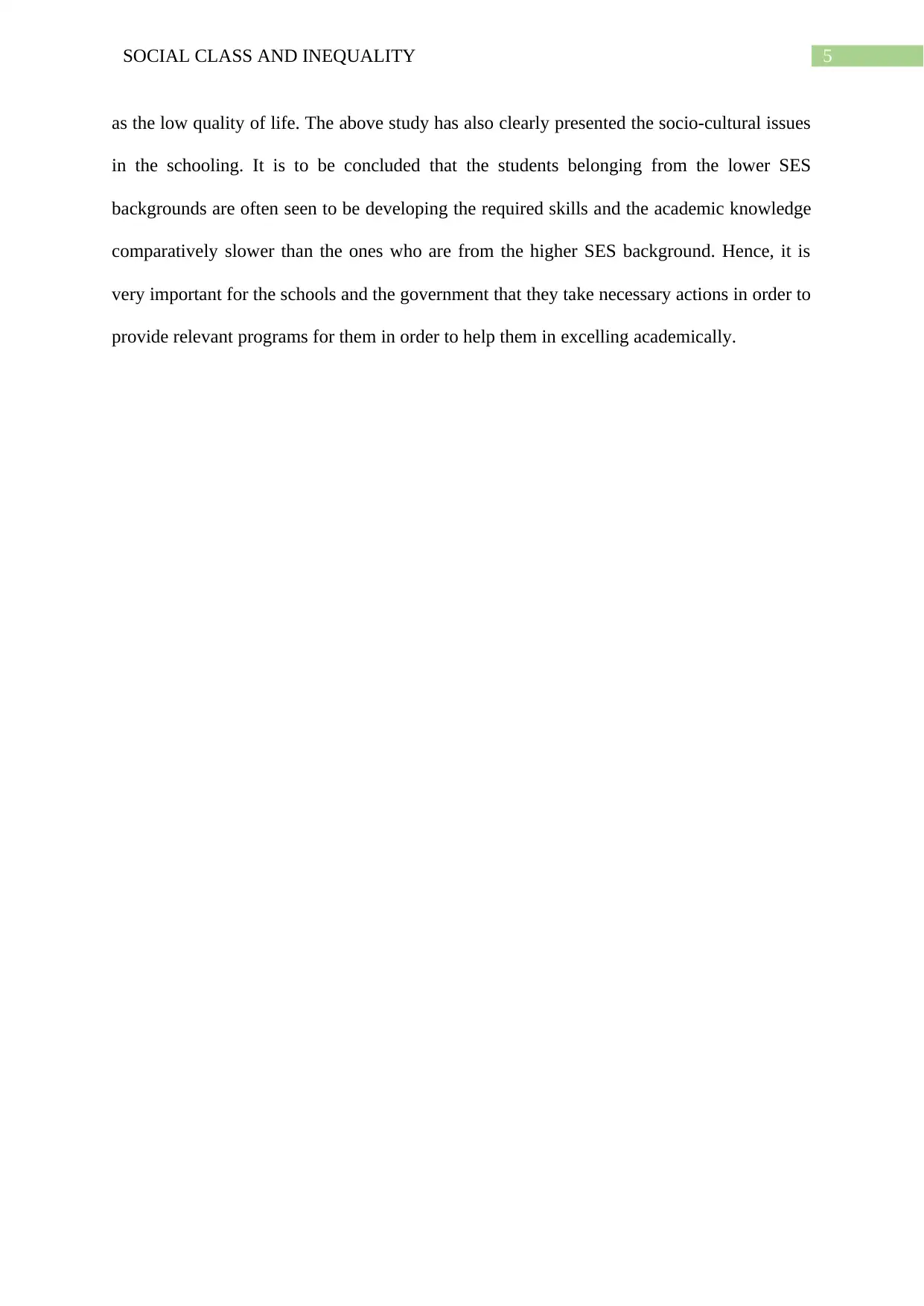
5SOCIAL CLASS AND INEQUALITY
as the low quality of life. The above study has also clearly presented the socio-cultural issues
in the schooling. It is to be concluded that the students belonging from the lower SES
backgrounds are often seen to be developing the required skills and the academic knowledge
comparatively slower than the ones who are from the higher SES background. Hence, it is
very important for the schools and the government that they take necessary actions in order to
provide relevant programs for them in order to help them in excelling academically.
as the low quality of life. The above study has also clearly presented the socio-cultural issues
in the schooling. It is to be concluded that the students belonging from the lower SES
backgrounds are often seen to be developing the required skills and the academic knowledge
comparatively slower than the ones who are from the higher SES background. Hence, it is
very important for the schools and the government that they take necessary actions in order to
provide relevant programs for them in order to help them in excelling academically.
⊘ This is a preview!⊘
Do you want full access?
Subscribe today to unlock all pages.

Trusted by 1+ million students worldwide
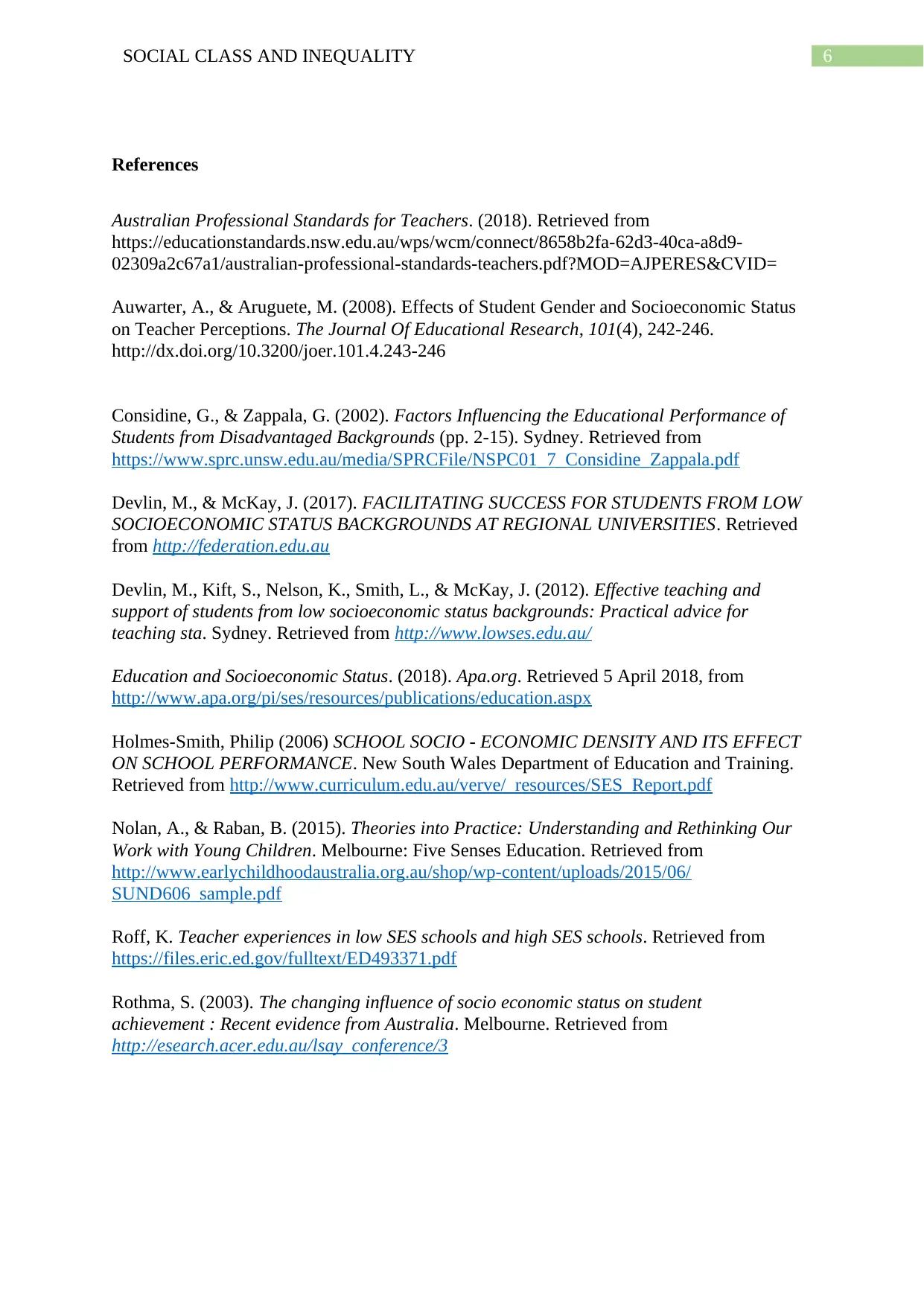
6SOCIAL CLASS AND INEQUALITY
References
Australian Professional Standards for Teachers. (2018). Retrieved from
https://educationstandards.nsw.edu.au/wps/wcm/connect/8658b2fa-62d3-40ca-a8d9-
02309a2c67a1/australian-professional-standards-teachers.pdf?MOD=AJPERES&CVID=
Auwarter, A., & Aruguete, M. (2008). Effects of Student Gender and Socioeconomic Status
on Teacher Perceptions. The Journal Of Educational Research, 101(4), 242-246.
http://dx.doi.org/10.3200/joer.101.4.243-246
Considine, G., & Zappala, G. (2002). Factors Influencing the Educational Performance of
Students from Disadvantaged Backgrounds (pp. 2-15). Sydney. Retrieved from
https://www.sprc.unsw.edu.au/media/SPRCFile/NSPC01_7_Considine_Zappala.pdf
Devlin, M., & McKay, J. (2017). FACILITATING SUCCESS FOR STUDENTS FROM LOW
SOCIOECONOMIC STATUS BACKGROUNDS AT REGIONAL UNIVERSITIES. Retrieved
from http://federation.edu.au
Devlin, M., Kift, S., Nelson, K., Smith, L., & McKay, J. (2012). Effective teaching and
support of students from low socioeconomic status backgrounds: Practical advice for
teaching sta. Sydney. Retrieved from http://www.lowses.edu.au/
Education and Socioeconomic Status. (2018). Apa.org. Retrieved 5 April 2018, from
http://www.apa.org/pi/ses/resources/publications/education.aspx
Holmes-Smith, Philip (2006) SCHOOL SOCIO - ECONOMIC DENSITY AND ITS EFFECT
ON SCHOOL PERFORMANCE. New South Wales Department of Education and Training.
Retrieved from http://www.curriculum.edu.au/verve/_resources/SES_Report.pdf
Nolan, A., & Raban, B. (2015). Theories into Practice: Understanding and Rethinking Our
Work with Young Children. Melbourne: Five Senses Education. Retrieved from
http://www.earlychildhoodaustralia.org.au/shop/wp-content/uploads/2015/06/
SUND606_sample.pdf
Roff, K. Teacher experiences in low SES schools and high SES schools. Retrieved from
https://files.eric.ed.gov/fulltext/ED493371.pdf
Rothma, S. (2003). The changing influence of socio economic status on student
achievement : Recent evidence from Australia. Melbourne. Retrieved from
http://esearch.acer.edu.au/lsay_conference/3
References
Australian Professional Standards for Teachers. (2018). Retrieved from
https://educationstandards.nsw.edu.au/wps/wcm/connect/8658b2fa-62d3-40ca-a8d9-
02309a2c67a1/australian-professional-standards-teachers.pdf?MOD=AJPERES&CVID=
Auwarter, A., & Aruguete, M. (2008). Effects of Student Gender and Socioeconomic Status
on Teacher Perceptions. The Journal Of Educational Research, 101(4), 242-246.
http://dx.doi.org/10.3200/joer.101.4.243-246
Considine, G., & Zappala, G. (2002). Factors Influencing the Educational Performance of
Students from Disadvantaged Backgrounds (pp. 2-15). Sydney. Retrieved from
https://www.sprc.unsw.edu.au/media/SPRCFile/NSPC01_7_Considine_Zappala.pdf
Devlin, M., & McKay, J. (2017). FACILITATING SUCCESS FOR STUDENTS FROM LOW
SOCIOECONOMIC STATUS BACKGROUNDS AT REGIONAL UNIVERSITIES. Retrieved
from http://federation.edu.au
Devlin, M., Kift, S., Nelson, K., Smith, L., & McKay, J. (2012). Effective teaching and
support of students from low socioeconomic status backgrounds: Practical advice for
teaching sta. Sydney. Retrieved from http://www.lowses.edu.au/
Education and Socioeconomic Status. (2018). Apa.org. Retrieved 5 April 2018, from
http://www.apa.org/pi/ses/resources/publications/education.aspx
Holmes-Smith, Philip (2006) SCHOOL SOCIO - ECONOMIC DENSITY AND ITS EFFECT
ON SCHOOL PERFORMANCE. New South Wales Department of Education and Training.
Retrieved from http://www.curriculum.edu.au/verve/_resources/SES_Report.pdf
Nolan, A., & Raban, B. (2015). Theories into Practice: Understanding and Rethinking Our
Work with Young Children. Melbourne: Five Senses Education. Retrieved from
http://www.earlychildhoodaustralia.org.au/shop/wp-content/uploads/2015/06/
SUND606_sample.pdf
Roff, K. Teacher experiences in low SES schools and high SES schools. Retrieved from
https://files.eric.ed.gov/fulltext/ED493371.pdf
Rothma, S. (2003). The changing influence of socio economic status on student
achievement : Recent evidence from Australia. Melbourne. Retrieved from
http://esearch.acer.edu.au/lsay_conference/3
Paraphrase This Document
Need a fresh take? Get an instant paraphrase of this document with our AI Paraphraser
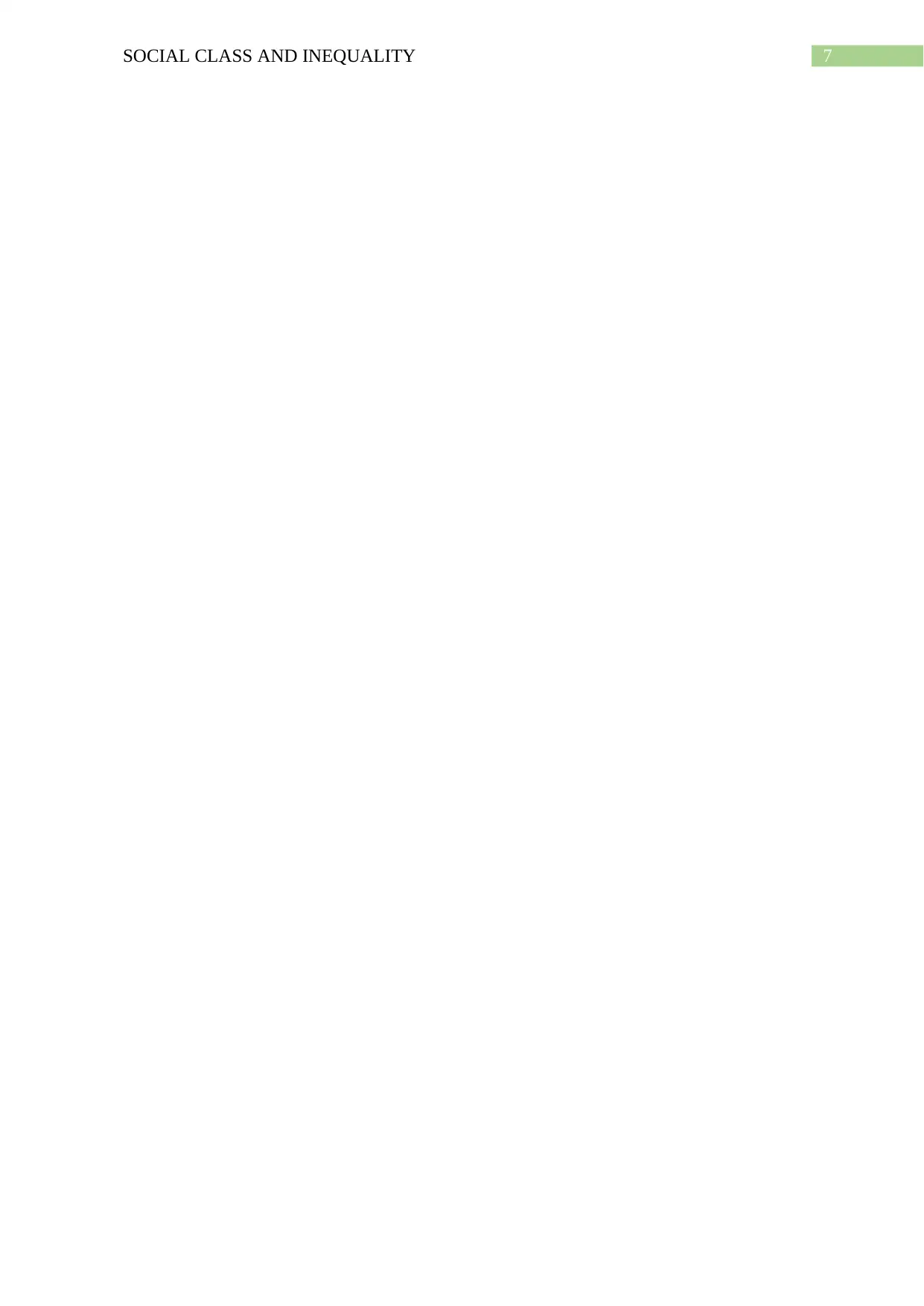
7SOCIAL CLASS AND INEQUALITY
1 out of 8
Related Documents
Your All-in-One AI-Powered Toolkit for Academic Success.
+13062052269
info@desklib.com
Available 24*7 on WhatsApp / Email
![[object Object]](/_next/static/media/star-bottom.7253800d.svg)
Unlock your academic potential
Copyright © 2020–2025 A2Z Services. All Rights Reserved. Developed and managed by ZUCOL.





